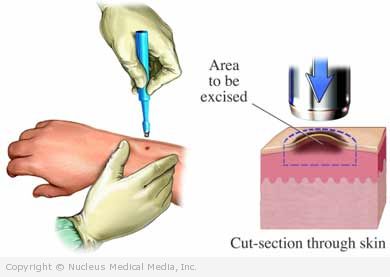Pemphigus – Pemphigus Syndromes
Pemphigus – Definition
Pemphigus is a group of rare autoimmune disorders. It causes large skin blisters. The immune system normally protects against germs and other foreign invaders. In this case, the immune system mistakenly attacks your own skin and mucus membranes. There are three forms of the disease:
- Pemphigus vulgaris — most common type of pemphigus; lesions may extend deep into the layers of the skin
- Pemphigus foliaceus — produces more superficial lesions
- Paraneoplastic pemphigus — most serious type; usually occurs in someone who has cancer
Pemphigus – Causes
The immune system produces antibodies. These cause the skin and mucus membranes to break out in blisters and burn-like sores. What causes the body to attack itself is not known. Sometimes a drug can cause symptoms.
Pemphigus – Risk Factors
Factors that increase your chance for pemphigus include:
- Family members with pemphigus
- A history of having autoimmune diseases, such as myasthenia gravis, lupus, or thymoma
- Age: middle to late adulthood
- Jewish or Mediterranean descent
- Regular use of certain drugs, including:
- Penicillamine
- Captopril
- Rifampin
- Piroxicam
- Penicillin
- Phenobarbital
Pemphigus – Symptoms
Itching and pain are common symptoms. Pemphigus may occur over a small or large section of the skin. Symptoms differ among the types.
Pemphigus Vulgaris
- Blisters usually start in the mouth or on the scalp
- Lesions progress to the face, neck, upper body, armpits, and groin
- Blisters also may occur in the esophagus, rectum, nose, throat, larynx (voice box), eyes, vulva, or rectum
- Surrounding skin may be red or normal color
- Pressure on the blister may cause it to expand into surrounding tissue
- Outer layer of skin can easily be rubbed off
- Blisters are soft and break easily, releasing fluid
- Open sores are painful
- Large areas of skin may open up, increasing the risk of fluid imbalance and infection
- Blisters usually heal without scarring, but skin color may change to brown
Pemphigus Foliaceus
- Blisters are itchy or produce a burning sensation
- Sores are usually not found in the mouth or on other mucus membranes
- Blisters usually first show up on the face, scalp, chest, or upper back
- Blisters open, causing shallow sores
- Skin is red
- Scales and crusts form
- Sunlight may make symptoms worse
Paraneoplastic Pemphigus
- Sores occur on the mucous membranes, in the mouth, eye, and esophagus
- Blisters often appear on palms of hands and soles of feet
- Lesions are itchy or painful
Pemphigus – Diagnosis
The doctor will ask about your symptoms and medical history. A physical exam will be done. This will include a thorough skin exam. Special care is given to examining the lesions.
Tests may include:
- Skin biopsies of the lesion and surrounding tissue
- Skin test to determine the level of antibodies by immunofluorescence
- Blood test to check the level of antibodies by immunofluorescence
Pemphigus – Treatment
There is no cure. Treatment aims to control the disease and prevent infection of the blistering lesions. The wounds are treated similarly to severe burns. Antibiotics and bandages with petroleum jelly will be used.
Early treatment produces better results. Even with treatment, a series of remissions and relapses usually occurs.
If left untreated, pemphigus can lead to death.
If a drug triggered the disease, the doctor will stop that medication. In some cases, stopping the drug is all that is needed for recovery.
Medication
Drugs can usually help control symptoms. The medications can produce serious side effects. Your doctor may order periodic blood and urine tests to check for adverse effects.
Drugs that may be given include the following:
- Oral steroids, such as Prednisone
- Topical steroids, including injection into specific lesions
- Immunosuppressive drugs (drugs that decrease your immune system’s ability to function), such as:
- Azathioprine (Imuran)
- Mycophenylate Mofetil
- Cyclophosphamide (Cytoxan)
- Methotrexate
- Gold
- Cyclosporine
- Rituximab is monoclonal antibody against a protein on certain white blood cells active in pemphigus
- Antimalarial drugs such as hydroxychloroquine (Plaquenil)
- A combination of nicotinamide and tetracycline
- Antibiotics (topical or oral) to treat any bacterial skin infections that occur
- IV immunoglobulin
- Viscous lidocaine mouthwash may numb the mouth and provide pain relief
- Sucralfate mouthwash may coat and soothe the mouth and provide pain relief
Plasmapheresis
For this procedure, whole blood is removed and the plasma is separated. The packed cells are then suspended in saline are reinjected. This is used in certain cases in combination with immunosuppressive drugs.
Lifestyle Changes
Good nutrition helps the body heal and fight disease. Some foods may also make your symptoms worse or trigger the onset of more sores. Some patients notice they are sensitive to garlic, onions, and leeks. Keep track of the foods that seem to cause a reaction in your skin and avoid these foods. Read the labels of all foods to make sure they do not contain small amounts of foods that can set off a reaction.
Soft diets may be necessary if you have oral lesions.
Surgery
In some cases of paraneoplastic pemphigus, surgical removal of the tumor may improve the disorder or decrease symptoms.
Pemphigus – Prevention
There are no guidelines for preventing pemphigus because the cause is unknown.

